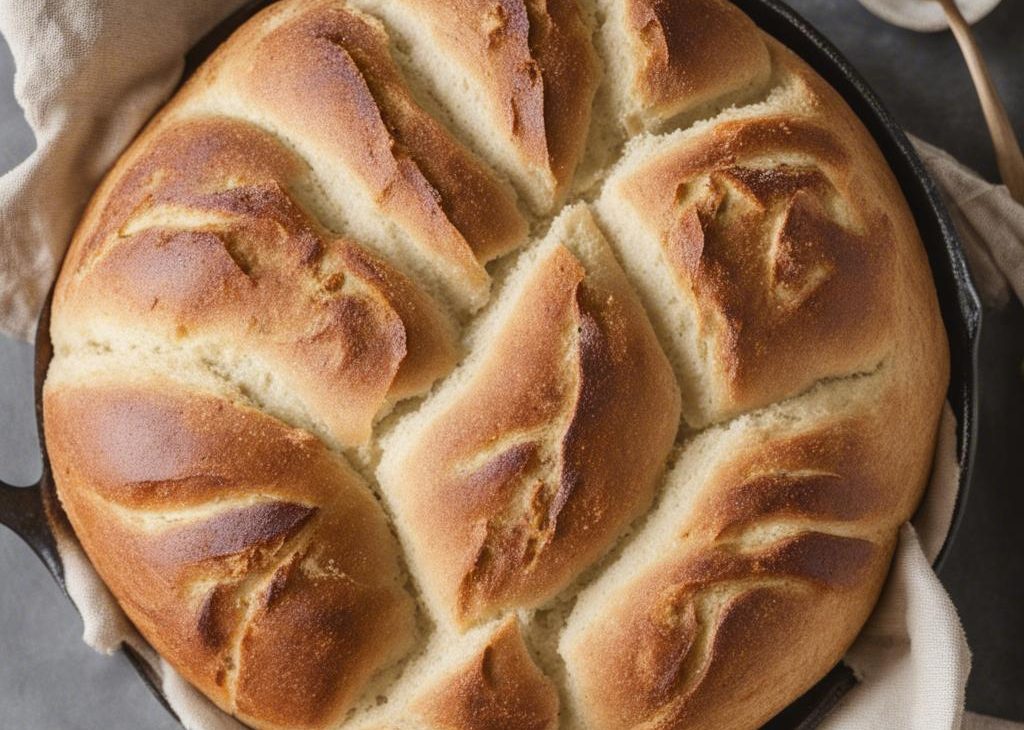


This chewy, cheesy asiago-crusted skillet bread is packed with the savory flavors of asiago cheese, plus a hint of garlic and black pepper. Baking the dough in a skillet helps form a thick and extra crispy bottom crust. You’ll use an easy no-knead method to make this yeast bread, which produces a beautiful homemade loaf with minimal hands-on work.
This recipe is brought to you in partnership with Red Star Yeast.
If you’ve ever had the pleasure of biting into an asiago bagel, you know how the salty, savory flavor of the asiago cheese mingles with the malty, yeasty flavor of the bagel in every chewy bite. And how the cheese sprinkled on top bakes in and forms a delicious crust on the exterior. (Are you drooling yet?!)
I wanted to replicate that wonderful flavor and chewy texture, but as a loaf of bread. This recipe nails it, and unlike homemade bagels, there’s NO kneading, individual shaping, or boiling steps involved.
Asiago cheese flavor: it’s an Italian alpine cow’s milk cheese, and the flavor ranges from mildly sweet and nutty to sharp and tangy, depending on how long it’s aged. A good substitute for the asiago in this bread recipe is freshly grated Parmesan, Pecorino-Romano, or white cheddar.
I use it in this savory sun-dried tomato quick bread, too.
I’ve found that some brands of asiago cheese can have a particularly… pungent aroma. But rest assured, that magically disappears during baking, and the baked bread will smell and taste absolutely delicious.
This no-knead method of making homemade bread is super popular among home bakers, and originally came from Jim Lahey of Sullivan Street Bakery in NYC. After using his method to make cranberry nut no-knead bread, many readers asked for more flavor variations. Since then, I’ve also published no-knead olive bread, super seeded oat bread, honey oat bread, and jalapeño cheddar bread.
I love making bread like this.
For today’s no-knead asiago bread, I made a few changes. Instead of letting the dough rest for 12–18 hours, we’re shortening that time to just 3 hours. We’re using a little more yeast (1 standard packet) to speed up the process. This is a bread you can start making the same day you plan to eat it and most of the “work” is completely hands off as the dough rises.
This process truly couldn’t be easier. Stir all the ingredients together by hand. Expect a very sticky dough:
Cover the bowl and let the dough rise for 3 hours. The dough will stretch to the sides of the bowl and have air bubbles on the surface:
Use a spatula to help remove the sticky dough from the bowl then use generously floured hands to shape the dough into a ball. Place it in an oven-safe skillet.
Let it rest for 30 minutes, and then score it with sharp knife or bread lame, top with more asiago cheese, and bake.
I love that this bread has a similar flavor to twisted cheese bread, but requires none of the complicated shaping.
Though I usually bake no-knead bread in a Dutch oven or on a baking sheet, I wanted the crust to be the main focus here. Baking the bread in a cast iron skillet helps develop a thick, extra crispy crust on the bottom.
If you need a recommendation, I own and love this cast-iron skillet. I have both the 10-inch and the 12-inch sizes and you can use either for this bread. They’re incredible quality for the price, and I use them to make all kinds of recipes, from skillet brownies to my Dutch baby pancake recipe, plus frittatas, skillet sea salt & herb rolls, honey cornbread, apple cider chicken, and more. Talk about a versatile pan to have in your kitchen!
Because of the sticky dough and cheese, this bread is flatter than most boules. But this just means a higher crust to interior ratio!
Keep this recipe on standby for when that craving for warm homemade cheese bread hits. Because you know when you start thinking about warm homemade cheese bread, you can’t stop thinking about it.
This asiago bread is simply perfect with a bowl of tomato soup and I love to dip it in homemade Italian dressing. Or serve it alongside:
Homemade bakery-style bread has never been easier. This no-knead asiago-crusted bread is baked in a skillet and requires minimal hands-on work! If you’re new to working with yeast, reference my Baking with Yeast Guide for answers to common yeast FAQs.